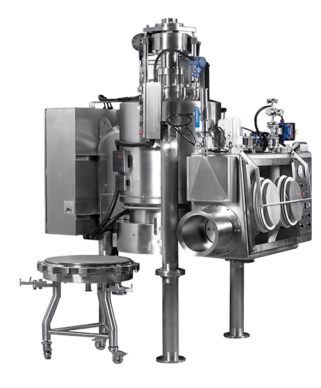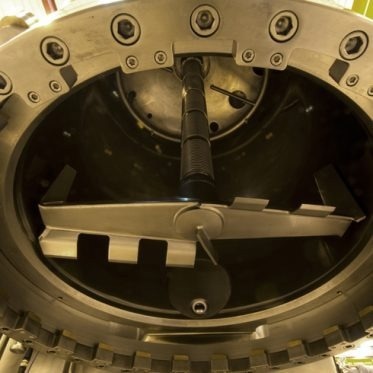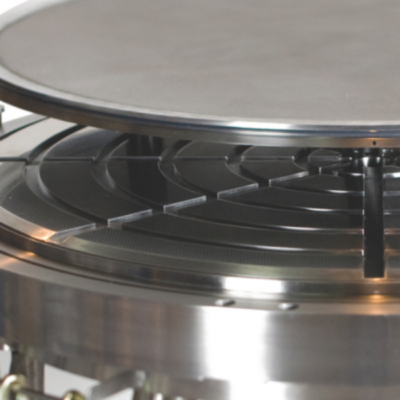Agitated Nutsche Filter Dryers (ANFDs) are essential in fine chemical and pharmaceutical manufacturing. These versatile pieces of equipment have a wide range of industrial applications, but their primary role is in filtering active pharmaceutical ingredients (APIs) following crystallization. This article will delve into how agitated nutsche filtering works.

Image Credit: Powder Systems
Understanding the Nutsche filtration and drying process
The key purpose of agitated nutsche filtration and drying is to isolate solids in batch-oriented processing. There are numerous ways to recover APIs from a slurry, but the clear benefit of nutsche filter dryers is that product washing, slurry filtration, and vacuum drying processes are combined into one unit.
Early versions of this technique involved an open vessel that would separate the solids from solutions through suction. However, this method was surpassed by enclosed designs introduced in the 1960s, which integrated the process into a closed system.
The adoption of enclosed designs not only facilitated greater process control but also allowed for the incorporation of agitation and pressure in nutsche filter systems. Additionally, it opened avenues for processing more potent compounds with extremely stringent Occupational Exposure Limits (OELs).

Image Credit: Powder Systems
Key components in an ANFD
Modern Agitated Nutsche Filter Dryers are typically comprised of five chief components:
- Jacketed Pressure Vessel: Designed for positive pressure or low vacuum levels, ensuring high sealing efficiency.
- Bi-Directional Agitator: Equipped with an adjustable stroke, offering distinct process effects in each direction.
- Base Filtration Element: Available in various configurations and pore sizes to suit diverse product profiles.
- Heating Elements: Facilitate precise temperature control, allowing for heating or cooling of the process as needed.
- Discharge Plug/Valve: This component is meticulously designed to facilitate maximum product recovery yield.
While these components constitute the essentials, supplementary parts are also available as needed. For instance, bayonet plugs facilitate quicker maintenance turnaround, integrated process cameras enhance method control efficiency, and dust filters ensure the containment of highly active ingredients.
Initiating filtration
The agitated nutsche filtration process starts when the slurry is added to the vessel, either gradually or in bulk. Generally, agitation begins after this initial step is complete. The agitator, a bladed drive assembly inside the vessel, is then started.
A low-speed, high-torque mixing action begins near the filter media to make sure the cake height does not affect the filtration rate. A gas pressure is then applied, and the separation of solid and liquid begins.
Filtration moves forward, and the blades of the agitator rise to the product cake top to remove cracks and/or preferential channels. This method offers quicker filtration rates compared to relying solely on gravity, enabling faster processing.

Image Credit: Powder Systems
Slurry washing
After the complete separation of API crystals, any residual filtrate and impurities need to be washed out. This process can be accomplished through either a traditional wash or a pre-slurry wash, with the latter typically being the preferred method. In a traditional wash, a solvent is introduced to permeate through the product cake, displacing impurities or traces of residual mother liquor. This step is often repeated multiple times to achieve optimal results.
A re-slurry wash, similar in process, involves the agitator plowing the solvent into the cake before pressing. This method involves fully resuspending solids, enhancing contact between solid surfaces and solvent, and reducing the total solvent volume needed for equivalent purity levels. Finally, any remaining liquid is pressure-filtered from the system.
Drying
Following washing, the drying process begins. Where necessary, there are two base options: vacuum-assisted heating or pressurized gas heating.
Optimal heat transfer within the vessel is necessary for both methods; therefore, heat transfer media is usually applied to the filter base, sidewall, and agitator blades. In addition, the agitator keeps serving a crucial function by providing gentle mixing and drying homogeneity.
The agitator ensures vertical homogeneity of the cake layers by raising/lowering as needed. Especially difficult products can be broken down by reversing the direction temporarily. This degree of specified control expands to the temperature-controlled zones as well. At the end of the process, these can be cooled down to reduce the product temperature to a safe level for manual intervention during discharge.
This is a critical and commonly the most challenging step, as the mixing action can be uniformly and precisely programmed throughout the process. Convective drying can significantly speed up process times as long as it is carried out effectively.
Dispensing the product
Lastly, the agitator is crucial in product discharge, slowly pushing the cake to the vessel wall and discharge plug. A funnel is typically utilized for optimized packing, and heel recovery can occur using an additional product rake.
About Powder Systems 
Powder Systems Limited (PSL) provides a full range of solid liquid separation solutions for filtration, drying, and processing from research and development activities up to larger commercial production scale.
Quality and innovation are central to everything they do. They are proud of their award-winning track record and have been working with industry partners for over 35 years.
PSL supports clients by developing solutions to overcome challenging manufacturing processes and provide first-class aftercare services.
Sponsored Content Policy: News-Medical.net publishes articles and related content that may be derived from sources where we have existing commercial relationships, provided such content adds value to the core editorial ethos of News-Medical.Net which is to educate and inform site visitors interested in medical research, science, medical devices and treatments.